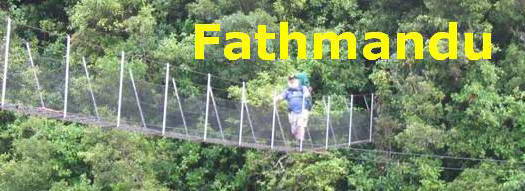
Many thanks for permission to use graphics from their software and toposheets |
 |
|
10 April 2008 Swanson Pipeline Track page 1 Right beside the Swanson Railway Station in Swanson Rd is Christian Rd and about 100m in from the corner Tram Valley Rd heads off to the right. It is tarsealed but narrow and winding and warrants a certain amount of care. At the end is a sign that directs you down an even narrower road to the start of the Swanson Pipeline Track some 300m on. It does not mention that at the end of 300m there is a No Parking sign in the only place available to park. On the other hand, it is a very small sign and it would be very easy to miss it.
For the most part the track is an old 4WD road presumably built to assist in the construction of the pipeline which follows hard beside. It is on the whole straight but crosses a number of reasonably steepish ridges, and in doing so provides an ideal training ground for Day One of the St James Walkway. About two thirds of the way along, the pipeline passes through a tunnel about 1.5m high and about 30 metres long. So do we. You will run out of light underfoot about a third of the way through, but the track is level and gravelled, and, at least when I was there, did not host cave wetas. There is a set of steps taking us uphill from the tunnel and a series of clay rises, culminating in a very steep climb up a lot of steps, to the water treatment station, where the park-like surroundings invite one to look, fruitlessly, for somewhere to sit and have lunch before heading back. On the grounds of steepness - no big slogs, but a number of small ones - and clay surface I would not recommend this track as a wet weather excursion. It would be very easy to slip in many parts of the track, and even now after a very dry summer, much of the clay is still remarkably soft. Right now, its a good walk, with a surprisingly varied vegetation cover along the way. Let's start then.
The estimate is a bit generous for a change. We do the entire return trip to Christian Rd, including a quick lunch, in just over two hours, and that includes time out on the way through for photographs.
At first it's a more or less standard 4WD track with the kind of course gravel I don't especially like as it's big enough and loose enough at times to move under your feet
It also looks to be scrubby with a good deal of gorse and such, but I'm soon drawn to the steep clay banks for a second look. Gorse, to be sure, but also mangemange, which is more often a product of forests than scrub, and some kiokio and small-leaved rata, and a seedling hangehange bottom right. Not a bad collection for a metre of scrubby bank.
We emerge into the open briefly, to grass and gorse and scrubby kanuka, and a bit of karamu over to the left.
but soon we're back intop some slightly more serious cover.
Above us, shining bronze in the sun is a ramarama. There's a bunch of trees in the bush that have this gold-bronze quality, and I particularly enjoy the quality they add to the local light.
Here's a maire, well out of it's usual haunts, accompanied by mapau and Coprosma grandifolia. The latter does have a non-latin name but it frequently escapes me.
Up ahead the scrubby kanuka has given way to an impressive kanuka canopy. I think it was Alan Esler who remarked that the 100 year plus life of these trees should cause us to rethink our "scrub" dismissal of them. They have an important role to play in the re-establishment of bush area, one that continues long after conventional "scrub" had disappeared.
Here's a pigeonwood. By now, I am sitting up and paying attention. This rather unprepossessing track is proving to have an unsuspected wealth of species. In the background I am conscious of tui calling and realise they have been there from the start also.
Despite the long and hot and rainless summer there are still plenty of soft patches, and I think I have probably made a good call in walking this one in the dry.
The pipeline looms out of the bush to our left. On the right a steep bank drops down to the stream below.
Here'sa bush lawyer looking in remarkably good health.
Here and there Coprosma grandifolia shows the odd bud in preparation for a flowering season which has it six months out of kilter with it's Coprosma fellows. In parts of Woodhill I have seen these "grand" leaves more than 250mm in length.
Nearby can be seen the small leraves of Coprosma spathulata (spoon-shaped leaves) and beside it a young kumarahou. The name of this plant, as of one or two others, makes me a little curious as to how the Maori name came to be altered in transition to the latin. It is, scientifically, Pomaderris kumeraho, "e" instead of "a" and missing the final letter. (The other one that springs to mind is Corokia for korokio.)
Down below the little ground-hugging bush lawyer, Rubus australis, is thriving, its leaflets in threes and the tiny prickles on the back of the leaf differentiating it from a couple of others with similar leaves.
|
|